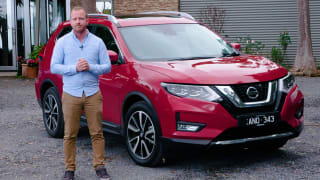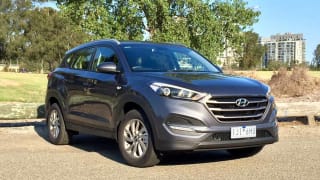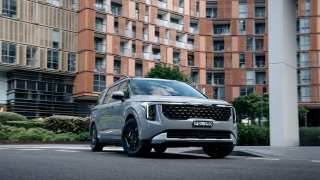There is a style leader in this pack, and it’s the Mazda.
The sleek looks of the CX-5 - even in this second-from-bottom-spec Maxx Sport model - meant it was the only one our testers deemed ‘desirable’ to look at and sit inside. It has a real presence on the road, even if there are tens of thousands of them around the place.
This particular colour, Deep Crystal Blue, does a lot of favours for the CX-5 - in white, the headlights and tail-lights can look a little squinty… simple solution, don’t buy a white one, and Mazda doesn’t ask you to pay extra for any of the colours except for Soul Red and Machine Grey ($300 for both of those).
But those LED headlights (and LED fog-lights, for that matter) add extra street presence: the rest of the vehicles here have those gross old yellowy halogen lights (not even projector beam, HID or xenon). The Mazda doesn’t have daytime running lights, though; the Honda and Holden both have LED DRLs, while the VW has halogen DRLs (yuck).
And Mazda is the only one to offer a sports pack (the thankfully sedate $2500 Kuroi styling option) if you wish to add some body kit elements - I mean, I personally don’t get the look of side skirts or a larger rear spoiler on an SUV like this, but some people dig it. I think side steps or underbody protection is much more appealing.
There’s no specific luxury pack or sport edition available in any model at this price point, but the Tiguan with the R-Line pack looks amazing… and is much more expensive.
Every tester was surprised that Volkswagen had the gusto to offer up a press vehicle in the orange hue you see here. It’s a great colour… or it was; because it’s been dropped now for the MY18.5 update, but it’s genuinely interesting to note how much smaller the Tiguan looks depending on the colour it is: when you see one on the road in white or silver, it looks bigger.
I like the styling of the Tiguan, but I think the mid-life update will be an important one: those headlights need some attention, because they really don’t gel with the idea of a ‘new’ SUV from a ‘semi-premium’ brand. The silver roof rails go a little way to helping out, but the boxy, muscular body of the VW helps it stand out on the road, more-so than the colour, in fact.
Inside, it’s typical VW, if done to a strict price. The material finishes all look high-spec, and there’s no doubting you’re in a European-engineered model when you sit inside.
The Honda has roof rails and pronounced wheel-arches filled by bigger alloys than the other vehicles here, but I would argue that it’s hard to call it a stylish vehicle: nope, it is what it is - unmistakably Honda. I like that the exterior design of the CR-V remained fairly true to its predecessor, but the rear-end leaves a little to be desired. The tail-lights don’t quite integrate as well as they should with the tailgate, though a lot of that comes down to the colour of our test car… it’s a bit of an old man colour (no offence, elderly gents!).
I think the Holden is a bit of a mess in terms of its styling. The headlights look like they’ve been plucked from a mid-1990s book on the future of car design, the rear looks like nothing else to have worn a Holden badge, while the side profile is like looking at a child’s drawing of a cyclone: there are lines everywhere.
It’s quite uninspiring to look at, and the story doesn’t get much better inside, either. More on that soon. But some of the Equinox’s awkwardness comes from its dimensions, and the size of these four varies pretty greatly: the Holden is the longest of these four at 4652mm, but isn’t the most broad-shouldered (1843mm wide) and measures 1661mm tall.
The Honda is second-longest (4596mm), but sits the tallest (1679mm) and spans the widest, too (1855mm).
Slightly smaller outside is the Mazda CX-5, measuring 4550mm long, 1675mm tall and 1840mm wide. We specify ‘slightly’ smaller outside, but the Mazda is definitely much smaller inside… more on that soon.
By far the smallest model here is the Volkswagen - in all exterior dimensions, in fact - it is just 4486mm long, 1839mm wide and 1648mm tall, and all of that makes its interior dimensions and packaging even more impressive. Check out the interior images to see what we mean - and you’ll notice in all of these models that the only trace of leather is on the steering wheel… you can forget leather seats at this level.
| Holden Equinox | Honda CR-V | Mazda CX-5 | Volkswagen Tiguan | |
| Score: | 5 | 6 | 9 | 8 |

















































